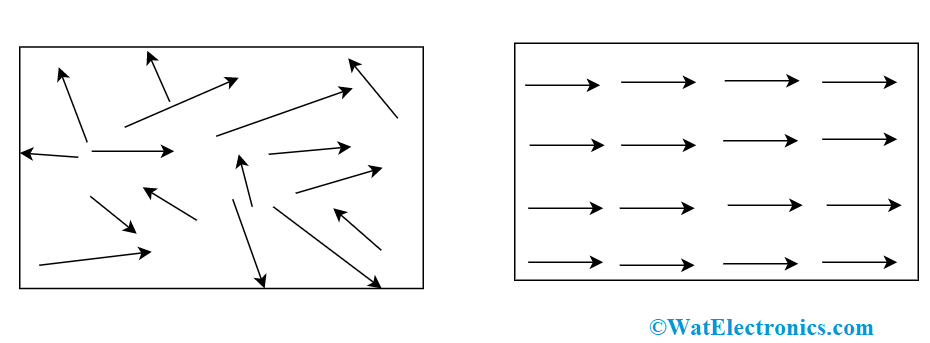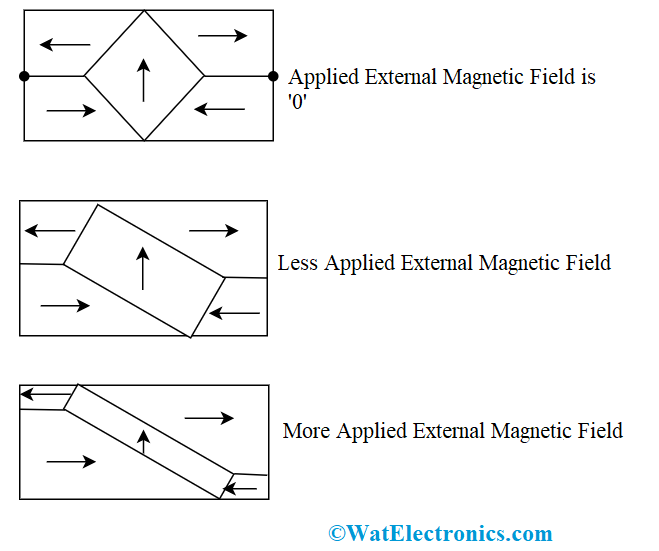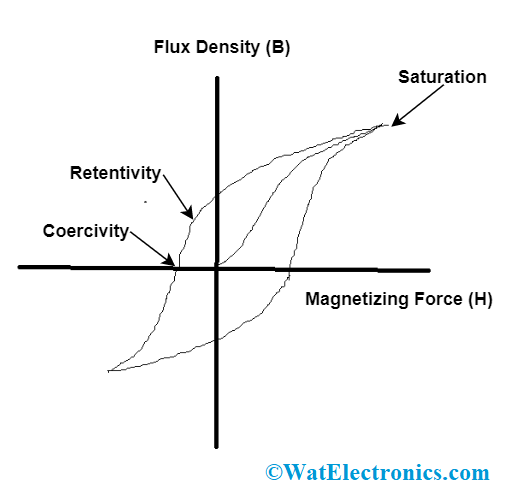For many decades, magnetism has been an anomaly that gained the sight of humanity. Any of the instances in mankind’s life, one might surely confront permanent magnets and so today we shall move with the discussion to know the concepts of magnetism and what ferromagnetism and ferromagnetic are? Initially, the concept of magnetism arises from the magnetic dipole moment of an electron which means that an electron acts like a small magnet generating the magnetic field. The swirl of the electrons in atoms is the crucial source of generating ferromagnetism even there exists support from the orbital angular momentum of an electron. Let’s move ahead to understand the detailed concepts of ferromagnetism and ferromagnetic materials.
What are the Ferromagnetic Materials?
Ferromagnetic materials are those which exhibit strong magnetic properties when placed in a similar direction of the field. At first, we shall know the concept of domain. It is generally a small locale in these materials that has a particular spin alignment because of quantum mechanical exertion. The permeability nature of these materials is extremely high, and it ranges almost several thousand. The reverse magnetic effects of the electron spin and orbital motion will not get eliminated in these materials. There exists a correspondingly substantial contribution from every atom that helps in the development of the internal magnetic field. Due to this internal magnetic field, the property of the magnetic field will be increased.

ferromagnetic material magnetization
In the scope of electrical engineering, it seems to completely suffice to categorize the magnetic materials as ferromagnetic and non-ferromagnetic. Ferromagnetic materials have the property of permeability more than one whereas non-ferromagnetic has permeability equals one. Ferromagnetic materials are categorized as
- Soft Type of Materials
- Hard Type of Materials
- Ferrites
Soft Ferromagnetic Materials
These materials exhibit the properties of high permeability, reduced coercive force, they can be magnetized and demagnetized simply and also exhibit low hysteresis. A few of the examples of these are iron, nickel, aluminum, tungsten, and cobalt. The process of easily magnetizing and demagnetizing let these materials to be implemented in the applications of generators, telephone receivers, electromagnets, transformers, inductors, relays and in many others. Even they are utilized for magnetic screening. The above-stated properties of these materials can also be enhanced through proper manufacturing and heating and slow galvanizing so that they gain an enhanced level of purity. Extended magnetic moment maintained at room temperature allows soft ferromagnetic materials to be used for magnetic circuits but then these are good conductors and deteriorate as because of eddy current which is developed inside them.
Hard Ferromagnetic Materials
These materials exhibit the properties of low permeability, extended coercive force, they are so complicated to get magnetized and demagnetized. A few of the examples of these are cobalt steel, nickel, few of the alloys of cobalt, and aluminum. They keep hold of a high range of their magnetization and maintain increased hysteresis also. The properties of these let them be implemented in speakers, measuring tools and in many others.
Ferrites
These are the separate classification of ferromagnetic materials that hold the properties between ferromagnetic and non-ferromagnetic materials. These are made up of tiny particles of ferromagnetic materials that have extreme permeability nature and they are all connected with a supporting resin. The magnetic moment in the ferrites holds great commercial value whereas magnetic saturation is not that much of ferromagnetic materials. These are also categorized as soft and hard ferrites.
• Soft Ferrites
These materials are with the properties of high resistance and have a square shape of hysteresis. The resistivity is in the range of almost 109 ohm-cm. Thus because eddy currents resulting from the alternating fields are so decreased and the properties exhibited by these materials allow them to be used in high frequencies like microwaves. Soft ferrites are manufactured through the combination of powdered oxides, condensing and sintering at extremely increased temperatures.
• Hard Ferrites
The crucial group of these kinds of ferromagnetic materials is with the composition of MOFe2O3 where M is Barium or Strontium. These are in a hexagonal shape and have high-density nature. These materials are employed in motors, generators, and relays. Even these are utilized as seals, latches, door closer and in the manufacturing various toys.
The Magnetization of Ferromagnetic Materials
These materials have distinctive magnetic moments that are aligned in parallel directions, whereas the other kinds of magnetic materials have the moment only is one direction. The north poles will easily attract the other direction poles, whereas the same poles repulse each other (North to North and South to South). They are with similar and opposite moments repulsing the other one.

ferromagnetic material magnetization
List of Ferromagnetic Materials
Below is the list of ferromagnetic materials
|
Material |
Curie Temperature | Magnetic Moment |
Nature and Applications |
|
Fe |
1043 |
2.22 |
Nanowires, shape-memory alloys and power generation, and distribution |
|
Co |
1388 | 1.72 |
Carbon nanotubes ad electronics |
|
Ni |
627 |
0.606 |
The scientific term for a sudden cooling |
|
Gd |
292 |
7.63 |
Neutron absorber in nuclear reactors |
|
Dy |
88 |
10.2 |
High magnetic susceptibility and easy polarization |
|
CrO2 |
386 | 2.03 | Magnetic tape emulsions |
| MnAs | 318 |
3.4 |
Rarely used ferromagnetic materials |
|
MnBi |
630 |
+ 3.6 Mn |
|
|
EuO |
69 | 6.8 | |
|
NiO/Fe |
858 |
2.4 |
|
| Y3Fe5O12 | 560 |
5.0 |
Concept of Hysteresis in Ferromagnetic Materials
When there is the removal of an external magnetic field, these materials will not get demagnetized to the whole. So as to let them lose complete magnetism, the reverse magnetic field has to be applied in the opposite direction. So, this procedure of ferromagnetic materials holding magnetization even the removal of the external field is termed hysteresis. And the material magnetization evaluated in magnetic flux density (B) v/s applied external magnetic field (H) will result in a loop and this is termed as a hysteresis loop. The figure clearly depicts this procedure.

ferromagnetic material hysteresis
Properties
Few of the properties exhibited by ferromagnetic materials are as discussed below:
- The atoms those are ferromagnetic substances are with permanent dipole moment and they have existed in domains.
- When the external magnetic field applied, the atomic dipoles in these substances are aligned in a similar direction.
- Exhibits extensive magnetic dipole moment and it is in the orientation of the magnetizing field. These materials are with high intensity of magnetization (M) and positive. M is in linear position with that of H (Magnetizing field). Thus, because saturation is completely based on material nature. These also have high and positive magnetic susceptibility (Xm), where Xm is defined as M/H, M corresponds to the intensity of magnetization and H corresponds to applied magnetic field strength.
- Ferromagnetic materials also function under high and positive magnetic flux density. Inside these materials, the magnetic field lines are so concentrated. Magnetic flux density (B) is defined as µ0(H + M) where µ0 is the free space magnetic permittivity, H is the applied magnetic field strength and M is the intensity of magnetization.
- These materials also have the nature of high relative permeability and it differs in linear with the magnetizing field. It also holds the propensity of attracting a greater number of magnetic lines of force and the relative permeability equals one.
- These materials have a strong tendency to get attracted by the field. Thus, in a non-uniform field, they will stay at the poles where the strong magnetic field exists.Liquefying these materials let those to lose ferromagnetic properties as because of increased temperatures.
Applications
There are two crucial technological applications of ferromagnetic materials. They are
- Used as flux multipliers developing the nucleus of electromagnetic machines
- Preservations of either data (magnetic recording) or energy (magnets).
The applications are
- Used for non-volatile data storage in hard drives, tapes and in many others.
- Employed in information processing because of the collaboration of electric light and power with magnetic influence.
- Utilized in the equipment like transducers, microphones, and capacitors.
- Implemented in the applications where those need extensive piezoelectric-coupling constant.
- Used in devices such as generators, telephone, loudspeakers, electric motors and magnetic strips at the backside of debit and credit cards.
In relation to that of other magnetic types, ferromagnetism is the most dominant one. These materials are found in a variety of applications Their advantages, properties, and applications allowed them to gain more prominence. Discuss more on the strategies of how ferromagnetic materials are functioned and their related concepts?
FAQ’s
1. What is called a curie temperature for ferromagnetic materials?
It is the temperature where the materials lose their ferromagnetic property and that can be retained through external magnetism.
2. What happens when ferromagnetic materials are heated at high temperatures?
They will completely lose their magnetic property and becomes paramagnetic in nature and it is because of the non-alignment of electrons.
3. How can a magnet be demagnetized?
There are various methods a demagnetize a magnet. They are of
- Heat above their allowed temperatures
- Position the magnet in reverse fields
- Hammer the magnets
- Placing magnets alone for longer periods
4. What is called retentivity and coercivity in ferromagnetism hysteresis?
Retentivity corresponds to the ability of the object to regain its magnetic nature when the magnetic force is stopped. Coercivity corresponds to the intensity of the magnetic field which is necessary to decrease the magnetic nature to zero.